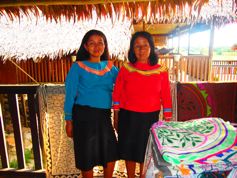The Shipibo community consists of about 35,000 people living in over three hundred villages concentrated in the Pucallpa region of Peru, none of them having electricity.
Despite modernization the Shipibo tribe maintains a strong tribal identity and retains many of their prehistoric shamanic traditions and beliefs. Among their traditions is the Ayahuasca ceremony.
Ayahuasca based cosmology is commonly depicted by Shipibo artisans, who are known for their intricate geometric designs and patterns.
The common figures in the Shipibo designs are the square, the rhombus, the cross and the octagon. The symmetry of the patterns emanating from the centre represents the inner and outer worlds.
The Shipibo women delicately paint on various size sheets of pure cotton adding colour from a blend of organic materials from the jungle. The jungle, mud material is applied with very fine sticks and dyes made from barks and fruit are used to tattoo the colour on the fabric.
Once the freehand design is completed by the women, they will start the elaborate embroidery process that can take as long as three months to complete. The unique and complex patterns woven in the fabric are an expression of the connectedness of creation and the ongoing dialogue with the spiritual world and powers of the rainforest. It is common for many women to work on the same piece collectively and they seem to be moved by the same artistic spirit resulting in a piece that will look like it was made from one single artist.
The village women use this skill to create income for themselves, therefore becoming less dependent and more empowered. For most of the Shipibo women this is their only source of income.
[product_catalog category=”shipibo tapestry” count=”6″ ]
